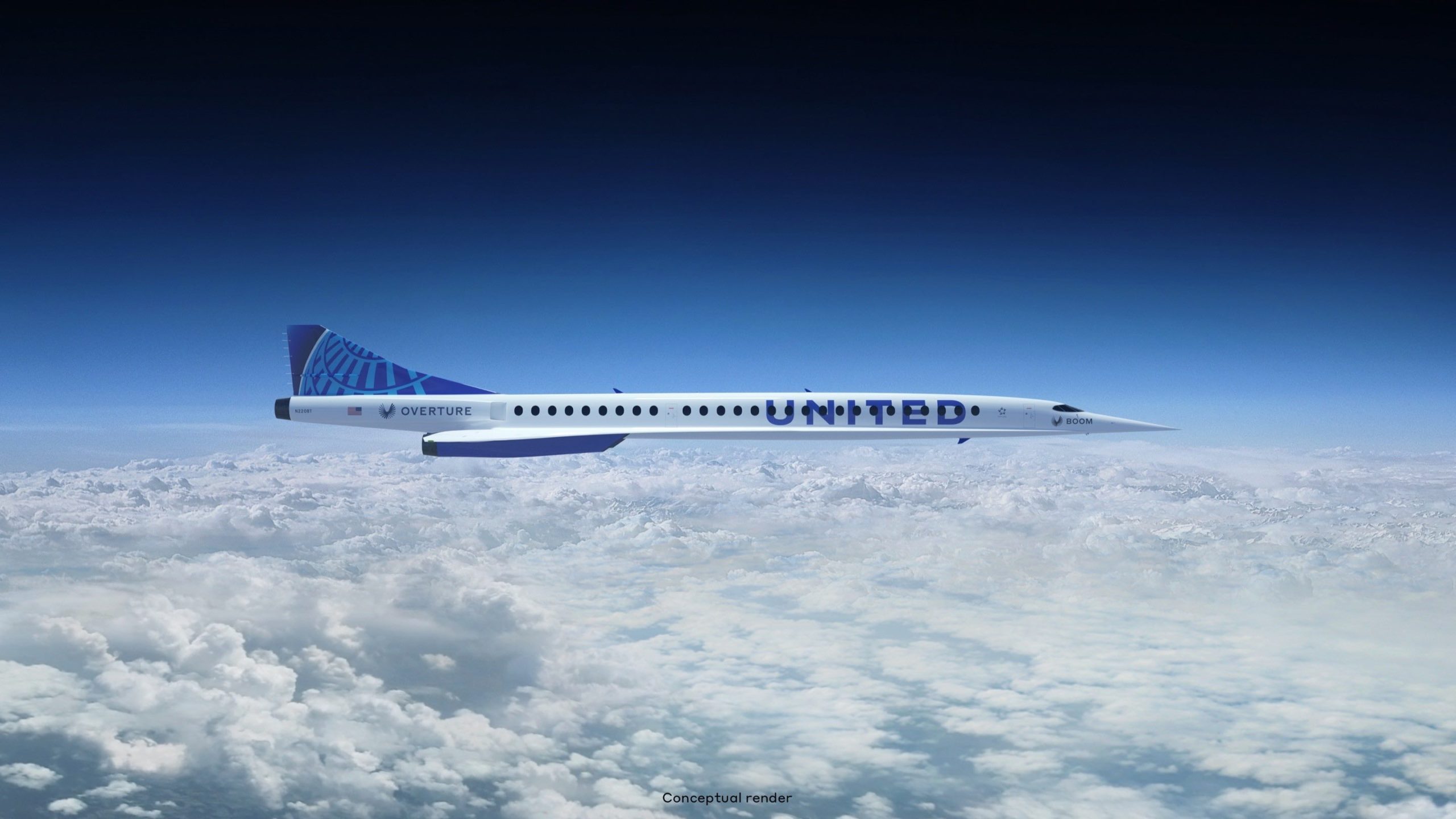
United Airlines has announced a firm order of 15 “Overture” jets from Denver-based aerospace company Boom Supersonic, with an option for 35 more, contingent upon the new airliner meeting United’s safety, operating and sustainability requirements.
United Airlines Orders Supersonic Jets
This answers the question of what United would reveal on Instagram on June 3, 2021.
Technology
The new supersonic jet by Boom Supersonic, dubbed Overture, promises the following technology:
- Passenger capacity: 65 – 88
- Length: 205 feet (about the same length as a Boeing 787-9 Dreamliner)
- Cruising altitude: 60,000 feet
- Speed: Mach 1.7 (Concorde had a cruising speed of Mach 2.02)
- Range: 4,250 nautical miles (4,888 miles)
- Emissions: Net-zero carbon emissions (using 100% sustainable aviation fuel [SAF])
Operating just under twice the speed of sound, This new Boom Overture jet promises to drastically cut air travel times, with new reduced transatlantic and transpacific flight times:
- New York to Frankfurt: four hours (currently seven hours)
- New York to London: three hours, 30 minutes (currently six hours, 30 minutes)
- San Francisco to Tokyo: six hours (currently 10 hours, 15 minute)
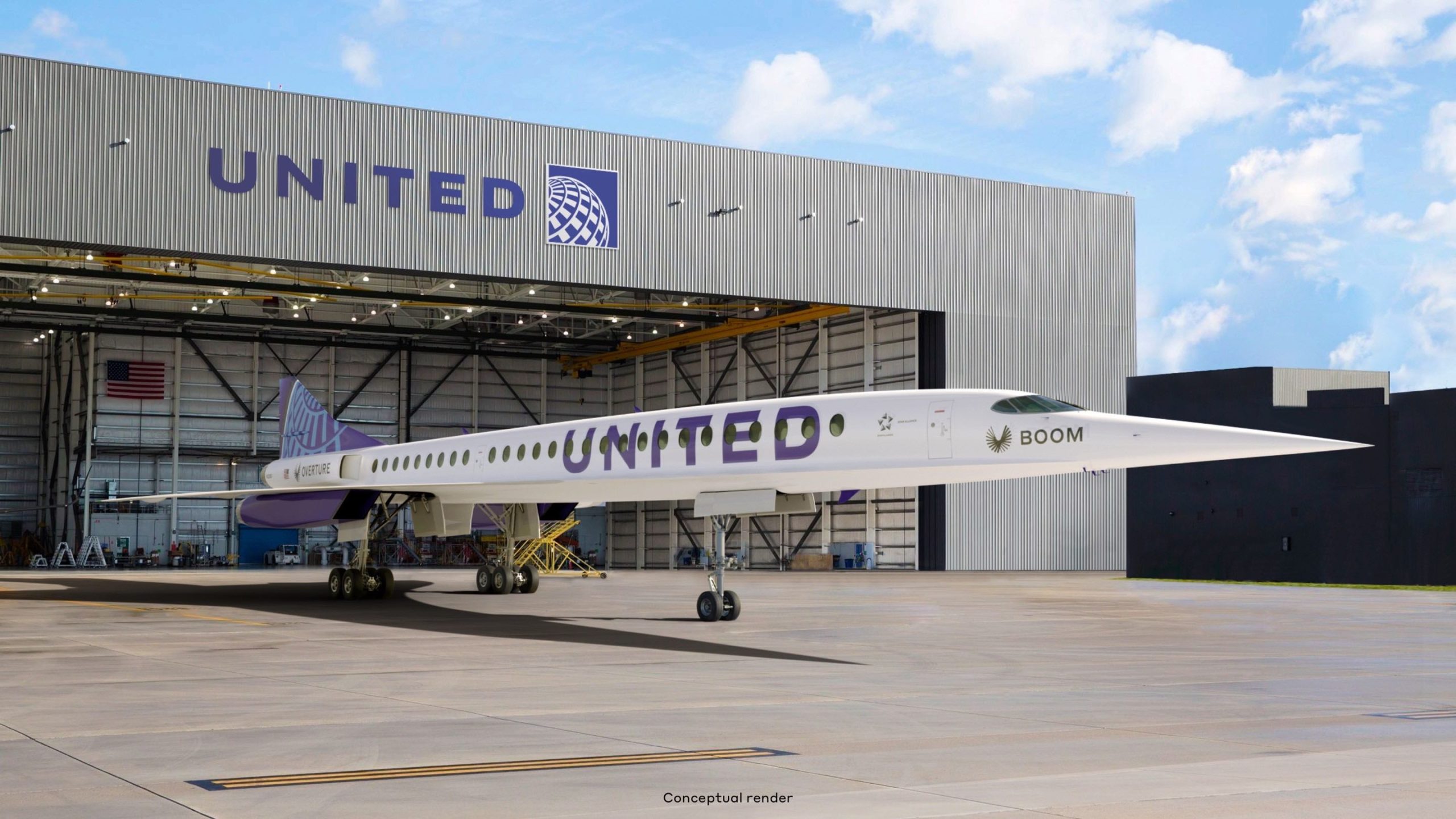
Timeline
Boom Supersonic plans to roll out the aircraft upon the following timeline:
- 2025 – rollout
- 2026 – first flight
- 2029 – enters passneger service
Onboard Product
More spacious than Concorde, the new Overture jet promises “comfort, productivity and privacy, featuring in-seat entertainment screens, ample personal space, and contactless technology.”
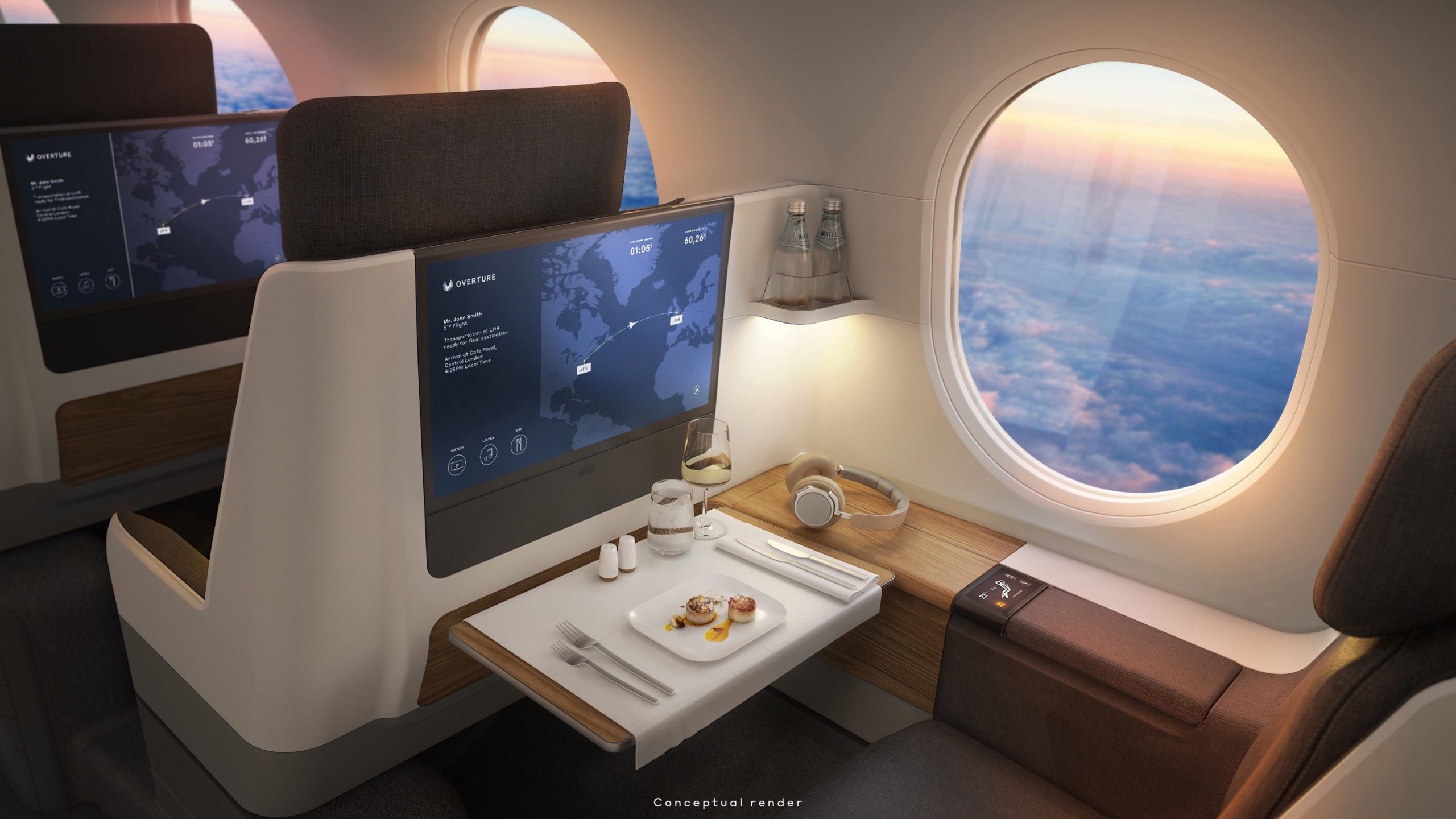
Based upon a single mock-up cabin rendering, it appears the aircraft can accommodate fully lie-flat business class seats in a 1-1 configuration.
Is This A Serious Order?
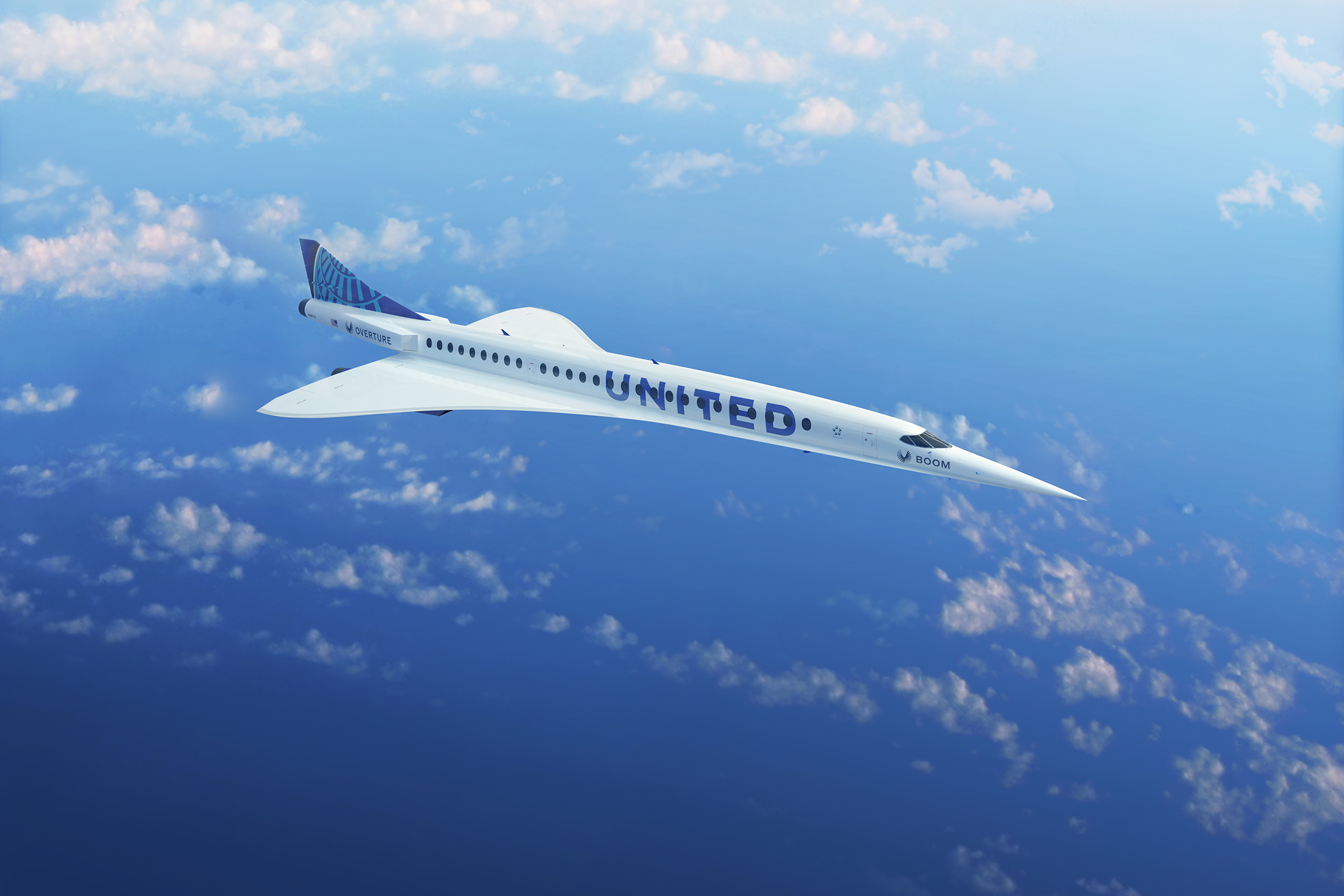
Despite being a “firm” order there are contingencies a mile long that likely give United tremendous amount of wiggle room. Not only must the new Boom supersonic aircraft obtain FAA safety certification: it must meet United’s new rigorous sustainability requirements.
United CEO Scott Kirby noted:
“United continues on its trajectory to build a more innovative, sustainable airline and today’s advancements in technology are making it more viable for that to include supersonic planes. Boom’s vision for the future of commercial aviation, combined with the industry’s most robust route network in the world, will give business and leisure travelers access to a stellar flight experience. Our mission has always been about connecting people and now working with Boom, we’ll be able to do that on an even greater scale.”
Boom Founder Blake Scholl added:
“The world’s first purchase agreement for net-zero carbon supersonic aircraft marks a significant step toward our mission to create a more accessible world. United and Boom share a common purpose—to unite the world safely and sustainably. At speeds twice as fast, United passengers will experience all the advantages of life lived in person, from deeper, more productive business relationships to longer, more relaxing vacations to far-off destinations.”
In all likelihood, United will have complete discretion over whether to proceed with this order due to inevitable production delays, inherent in virtually any new aviation-related technological innovation.
CONCLUSION
There’s excitement surrounding this announcement because a supersonic jet has not transported passengers since Concorde’s untimely retirement in 2003. As Jon Ostrower noted, the last time United ordered supersonic aircraft, humans had not walked on the moon. While this particular model may never take off, the new partnership between Boom and United demonstrate the longing for faster air travel. That it may be done without pollution is all the more exciting. The two companies will work together to carry passengers at supersonic levels again. I am rooting for their success.
Can you imagine United Airlines supersonic jets by the end of the decade?

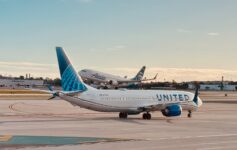
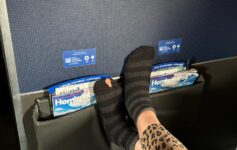

Well, the reality is that who would have imagined Tesla being this successful a decade ago. While I think the timeline is optimistic, I can very much see this happening by the end of the decade.
On another note, what genius came up with calling this aircraft, “Boom.” Really?
Toldja! Lame!
Personally, I do not want to cross the Pacific in 2 1/2 – 3 hours. I quite like my 14-16 transpacific flights as they provide time to relax, catch-up on work, work on special work-related projects that I otherwise don’t get around to, read a book, enjoy a meal, sleep, etc. Speed is not always a good thing.
That said, if this does become reality, I’d expect it to be much like Concorde in that it would supplement, and not supplant, subsonic service.
Well with a range of 4200miles how is this plane going to make SFO-NRT a reality? haha. i can see the plane being extremely valuable for the NYC-Europe market though.
Essentially the same constraint as Concorde: range, and unless that can be dramatically increased, then it will be a repeat of Concorde’s routes, ie trans Atlantic ( and probably successful) but pretty useless elsewhere…
I question whether there will be a big enough market for these to be viable. There is no question that supersonic flying will be both more expensive and have a higher environmental impact. The vast majority of flyers choose flights based on cost, not travel time, and even less price-sensistive business travelers have less incentive to pay more than they did in the past given the fact that flights now offer quality sleep (in J/F) and productivity (with increasingly good internet access). Don’t get me wrong, I would LOVE to take a supersonic flight, but put me down as very skeptical that the next 20 years will see any meaningful move toward it being the norm.
I’ve been reading more about this today and the one thing I can’t grasp is whether the noise issue is the same as with the Concorde. This was always a significant problem with Concorde and as such restricted its intended use over water unless flying at conventional speeds. So, like Paolo says, it pretty much will put this aircraft right back to where Concorde was. A niche that will only offer service at close to coast airports serving high yield passengers (JFK, IAD, BOS, LHR, CDG).
I flew Concorde twice in the 90’s back when USAirways allowed redemptions on BA Concorde flights out of Dulles. I feel fortunate as would never have paid for it otherwise. Honestly though, other than the novelty (which wears off after the first flight) I much prefer the comfort of a F wide body seat – and after two roundtrips never booked it again while it was offered. I recall it being around 150K points R/T at the time – which in retrospect was an amazing deal!
I actually don’t care for the idea and that’s because I enjoy long-hauls in J and F. Between NYC and London at 3:30 hrs, there would be no incentive to spend all those points (or cash) for a lay flat seat. It would be like spending +$3.5k on a IAH to EWR flight. For me, meh, not something I would seek out.
The range is a bit short for westbound SFO-HND. Even if solved, a connection will greatly reduce the time savings to Taiwan, China, Hong Kong, Singapore, etc. but there could be brief technical stops to reduce time on the ground.
The plane looks fake because it’s unclear if baggage is stored under the floor of the cabin. In a CRJ, I think the baggage is behind the cabin, not underneath.
I put a higher probability on the A350s being delivered……and even then I doubt they will ever show up on property.
LOL as if this is serious.